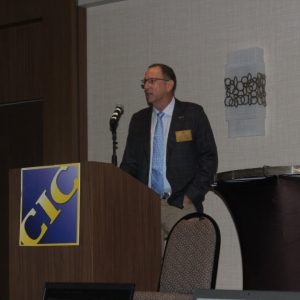Industry News Site Preview
CIC Chairman Demands Better of Auto Industry
By Louis Schuler
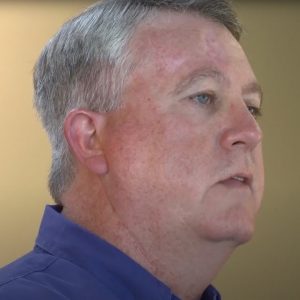
I-CAR via YouTube
Collision Industry Conference (CIC) Chairman Jeff Peevy is imploring the automobile industry to increase the quality of their work, particularly in terms of keeping consistent transparency with their customers and keeping up on industry trends. According to Repairer Driven News, he chided businesses for being stuck in the ‘old ways’ without adjusting to the ever-changing technologies that have been made readily available to the automobile repair market.What’s perhaps a more pressing issue is whether most repair shops use OEM procedures when going about a repair, too. In a poll conducted by the CIC, an underwhelming 39 percent of shops surveyed reported using them under normal circumstances during routine repairs. In terms of the current state of the repair industry, Peevy said it is undergoing a “technical tsunami” and that the market at large is “under water” in trying to adapt to the necessary changes needed to conduct business in the industry. And to compound the issue, only 19% of respondents polled were “confident” they had identified “all OEM procedures.”
Kevin Earlywine, Director of Data Analytics at Full Impact Technologies, told Leif’s Auto Collision Center that he makes sure repair technicians have everything they need in the pre-repair phase so they can minimize down-time and optimally operate a repair. His company has developed a program to increase accuracy of the estimating phase, too. Specifically, his program takes “snapshots” of the estimate
at different phases of the repair to see how accurate the final bill is.
“We developed this software program that wants to score the accuracy of that estimate,” said Earlywine. “Because if you look at it, you got tons of KPIs throughout the repair facility –cycle time, touch time, CSI, capture rate, etc.– but there’s nothing that grades the accuracy of that estimate.”
As far as whether repair shops are implementing OE procedures, or if the repair costs are too high, Earlywine attributed this to an array of possibilities, including a combination of intractability on the technician’s part, insufficient training and abstract OE procedural jargon that technicians sometimes may not fully understand.
“You’ll see that the amount of shops that are really trained across the industry is really not a super high number percentage-wise. So I think that plays a role in it, too, because we’re still not as an industry getting all the training we need.”
In fact, I-CAR, the Inter-Industry Conference on Auto Collision Repair, according to their website, is one of the industry standards within the automotive repair market when it comes to certifying repair shops across the country. In late 2016, the nonprofit organization reported that only 9,325 repair shops out of the approximate 33,500 in the market went through the I-Car training program, which amounts to about 28 percent. In the subsequent year, the organization reported about 33 percent of the industry trained with I-Car. And in 2018, 59 percent of the 33,500 total shops said they were not training in general. Therefore, a slight improvement has been made in the industry over the years.
But according to Earlywine, there is still plenty of more work to do, especially with regard to improved comprehension of original equipment (OE) manuals.
“We’re really pushing for OEs to do a better job –and not saying they’re doing a bad job– but try to make those things as clear and concise for the common technician out there in the body shop.”
With regard to technicians, Earlywine also noted many in the industry are less inclined to change their ways despite the industry constantly evolving with regard to different technological advancements on automobiles. This especially applies to cars that were made before the 21st century, for many reasons. Mainly, because hardly any of them had the technological capabilities of today’s standards–dash-cams, integrated GPS systems, autonomous driving, etc.
“You got a lot of cowboys out there. And what I mean by that is really people still tend to think ‘hey I’ve been doing this for 20 years or whatever, I know what I am doing; I am familiar with the vehicle, I’ve repaired it before.’ And they do the repair and they don’t feel the need to do any research or anything.”
Part of the problem could be related to whether there is simply too much paperwork, or know-how involved with wholly adhering to OEM procedures. Another poll found that 59 percent of respondents had “sleepless nights” wondering whether they had correctly implemented every OEM procedure. So part of the issue could be whether the OE handbook guide(s) relative to the necessary repairs are too complicated for technicians to understand.
Either way, as technology becomes more advanced, questions become more apparent as to what should be expected of insurance estimators. Typically, estimators are tasked with assessing damages on a vehicle–that is, what can be visibly seen. However, as new technological advancements present themselves in the industry, the question then becomes how estimators can assess these damages–which many of them can be internally based.
And regardless of whether buyers or the repair industry adapt to the trend, a 2018 study by PwC Statista found that automotive electronics currently makeup about 35 percent of total car costs worldwide in 2020. But that figure is expected to dramatically increase to approximately 50 percent by 2030 as technology proliferates. That ratio is more than three times the amount of electrical costs in the 1990s, which totaled about 15 percent.
On the positive side, the repair industry is showing progress combating these issues and adapting to new challenges. The same referenced study showed most repaired shops polled require documentation to “ensure payment for non-visual damages.” Some of these include important items such as: scan printouts, copy of OE procedures, calibrations and measurement specifications. Of the shops polled, 93 percent reported using the aforementioned documents.
Couple Sues State Farm, Repair Shop after Horrific Crash
By Louis Schuler
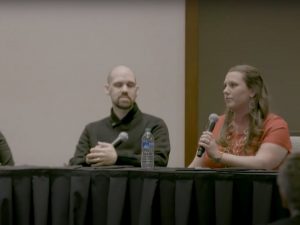
Collision Industry Conference via YouTube
Sometimes cutting corners on a repair can have innocuous effects; in other circumstances, it can have tragic consequences.
The latter would seem to be true in this case, wherein a customer suffered fourth-degree burns due to negligent repairs in Dallas, Texas, according to Repairer Driven News. In a display of incredible corporate avarice, State Farm Insurance allegedly pressured John Eagle Collision Center to cut corners on a repair for the car, which played an almost fatal role in a subsequent car crash in December 2013, according to an outside settlement. While State Farm has since denied having influenced the repair shop, inspection of the 2010 Honda Fit revealed that its roof had received poor repairs months prior to purchase, which was allegedly not disclosed to the Seebachans on the Carfax report.
The story began when Marcia and Matthew Seebachan were driving en route to their holiday destination in Texas Hill Country, located in the Central and Southern parts of the state. They were initially on their way to see Marcia’s grandmother when a Toyota Tundra pickup hit their car on the front-end after hydroplaning. The ensuing fallout was a disaster; the car’s roof buckled after impact, engulfing the car in flames and trapping the Seebachans inside.

Todd Tracy Law Firm via YouTube
As per the deposition, repair shop owner Boyce Willis stated that while their repair shop –the defendant, John Eagle Collision– generally abides by the manufacturer specifications within the Honda Fit Body Repair Manual. Hence, they were pressured by State Farm Insurance to glue on the roof of the automobile rather than weld it.
According to the deposition, Willis claimed that their repair policy is “guided by insurance,” and implied that much of their business is dictated by insurance companies.
“So … if you brought your car into my shop, right, the insurance company’s going to dictate… how we’re going to repair your car,” Willis said during the deposition according to Body Shop Business.
Todd Tracy, lawyer for the plaintiffs, then asked if insurance companies can override whether OEM (Original Equipment Manufactured) parts are used for vehicles.
“Yes, they can,” Willis responded. “By not paying the bill.”
In an interview with Leif’s Garage, Tracy stated that prior repairs were the main reason for the car to swiftly buckle under the pressure. In his 30 years of experience, it was one of the rarer instances of a complete failure of structural integrity for the car.
“The Seebachan accident was unique in that I had never seen a roof structure perform in such a contradictory manner to engineering and physics,” Tracy said via email. “Specifically, the roof literally absorbed no energy. Once we dug into the design and ultimately the repairs, we learned that the defective repair was the sole cause for the destruction of the energy absorption capability of the vehicle.”
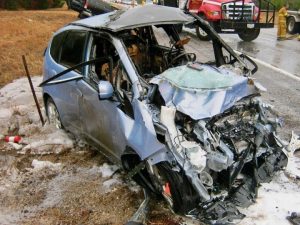
Todd Tracy Law Firm via Facebook
Even one of the defending attorneys on the case (who wished to remain anonymous during a phone interview with Leif’s Garage) remarked how the insurer factored into how the prior repairs were made to the vehicle. However, he didn’t cede his clientele and shared the brunt of the blame.
“(The inferior repairs) were certainly directed by the insurers in terms of what was supposed to be done to the vehicle,” the lawyer claimed. “Neither party was ultimately responsible, because the crash forces were the real culprit since it was in a high-speed funnel collision.”
While they survived the near fatal collision, their injuries –both mental and physical– were permanent. For starters, Matthew was inflicted with caustic burns on his lower body, including his legs and feet, before rescue from a nearby motorist. His wife also survived after being pulled out from the passenger-side window.
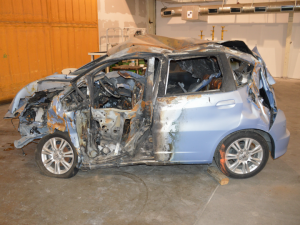
Renee Williams via The Tracy Firm
Their injuries were tremendous and would have lasting effects. According to AutoBody News, Marcia was able to recover the quickest, but her injuries were nothing short of catastrophic. She suffered a broken arm, wrist, femur, feet and pelvis, perforated intestines and torn aorta lining. In addition, she received multiple surgeries to repair muscle tendons attached from her skull to her spine.
Her husband also sustained heavy occupational damages. Due to the tragic extent of his injuries, Matthew was forced to postpone his training to become a nurse. In her testimony, Marcia recounted her husband’s legs were trapped in the car while it was on fire, “exposing the bone in some places.” The couple also had to forego their dreams of becoming foster parents.
According to The Dallas Morning News, the Seebachans purchased the Honda Fit just four months before the crash. After buying the vehicle, the CARFAX report also neglected to mention the faulty repairs done on the car, which was a crucial factor in the damage, as per the lawsuit stated. The suit alleges that this eventually led to a chain reaction, which involved the compression of the car’s safety cage and subsequent explosion of the fuel tank located below and behind the driver’s seat.
In the end, the jury concluded the shop was 75 percent accountable for the plaintiff’s anguish, with the driver of the Toyota Tundra paying the remaining 25 percent; the amount totaling about $10.2 million of the $42 million verdict. To make the situation increasingly convoluted, Marcia stated during her testimony that the initial damage to the roof was never made known to them prior to purchasing the car. To this day, it’s unknown whether State Farm paid their fair share.
However, in an exclusive case, the Seebachans filed a lawsuit against State Farm Insurance for their part in the faulty repairs. That suit was settled outside of court. But according to the plaintiff’s complaint, the company played a vital role for the car’s poor repairs. In fact, one of the lines in the complaint made a scathing accusation of the insurance company.
“State Farm claims that it is a ‘good neighbor’ by being there for its customers,” the complaint reads. “Yet, State Farm’s supposed ‘good neighbor’ policy was nowhere to be seen when it paid John Eagle Collision Center for ignoring Honda’s body repair specifications.”
According to Tracy, there was never any mention of the prior repairs upon purchase, only reports about “upholstery work” in their CARFAX invoice. Marcia stated via repairerdrivennews.com that the invoice was “completely inaccurate” going further asserting it had been “repaired poorly.”
Overall, Marcia Seebachan cited the case as being ‘resolved satisfactorily’ but the trauma and personal injuries will likely be remembered into perpetuity. This is especially true for her husband, Matthew, who had been in excruciating pain. He underwent two years of treatment for his burns, including multiple skin grafts and thirteen surgeries, according to Robert Kreisman—writing for Kreisman Law Offices in Chicago, Illinois. As of 2018, he still wasn’t able to put any pressure on his feet and had to resort to a walker for transportation.
In an interview with Leif’s Garage, Collision Industry Conference Chairman Jeff Peevy recounted it wasn’t the worst collision he has seen but was wary about whether State Farm was solely to blame.
“It wasn’t the worst (crash), but it was one I knew the injuries could have been minimized because our industry had repaired it and we had the opportunity to repair it correctly and safely,” said Peevy via email.
He added that the repair market took the brunt of the blame in this case.
“I speculate on their (State Farm’s) role, but I think because I was a technician and have been involved in technical training for so many years, I place the responsibility on the industry,” said Peevy. “So many in our industry, at least to some degree, have accepted to repair vehicles without proper equipment or without proper training.”
Unfortunately, stories like these are somewhat common in our industry when it comes to shoddy repairs. Oftentimes we will get cars that are the result of a subpar repair job from other shops, too, making it all the more important to carefully consider what repair shop you want to go with. This makes it all the more necessary to research the body shop before taking your car in to be restored to pre-loss condition.
“If State Farm or any insurer for that matter pressures any repair facility with financial ruin; if that repair facility refuses to follow the insurers’ dangerous and potentially deadly repair scheme, then that insurer should be held civilly and criminally responsible,” said Tracy. “This is why repair legislation is so critical that requires repairs to be dictated by OEMs not insurers.”
While the Seebachans didn’t come away from the wreckage unscathed, they were fortunate to win the main case against John Eagle Collision and reach a settlement with State Farm outside of court. In fact, not all individuals –see the Illinois Supreme Court case– who go into litigation against large insurance companies come out on the winning end. Luckily for the industry at large, cases like these can help promote change on the market and therefore the customer. Dallas lawyer Tracy is an advocate for this, saying the case helps move the goalpost on keeping repair shops and insurance companies more accountable.
“This case is bigger than money,” said Tracy via Dallas Morning News. “This case is about industry-wide change.”
When Insurance Companies Deny Personal Injury Protection Claims
By Megan Wallin Kerth

“Madagascan Day Gecko” by Bernard Spragg via Flickr
Geico’s Denial of Personal Injury Protection (PIP) Claims Results in Lawsuit
On April 2, 2020, the Florida Spine & Joint Institute (FSJI) filed its suit against GEICO for over $750,000 in damages, claiming GEICO had been denying legitimate PIP claims, as well as defaming FSJI’s practices and failing to meet contractual relations, as reported by Matt Naham, managing editor of Law & Crime. Although GEICO eventually offered to pay the PIP claims they had originally denied, FSJI pointed out this only made it clearer that they were aware of those claims’ validity; as such, denying those claims in the first place was “systemic fraud.” On their end, FSJI had done plenty of damage control, even changing their name in an effort to distance themselves from the insurance company’s false accusations of fraud. They insisted GEICO pay for damages and attorney fees, as well as the denied claims. Though the claim has now been resolved, denied PIP claims are no small matter.
PIP claims, or personal injury protection claims, are common after a car accident, as medical bills and lost wages can add up quickly. In cases where there is a death, PIP even covers funeral expenses (Forbes, 2020). While many people may initially only be concerned about the damage done to their vehicle, the Health Care Cost Institute (HCCI) reported that emergency room costs have experienced a staggering 176 percent increase in the past decade. Knowing the rising costs of both emergency care and medical bills, it would seem that GEICO, the second most largest auto insurance company in the United States, would be well equipped to handle personal injury claims and protect their customers. Instead, the recent lawsuit filed by the FSJI alleges that the insurance giant is side stepping their duty to cover personal injury costs for clients.

“Here We Go Again” by EX22218 – ON/OFF via Flickr
The Purpose of PIP Coverage
For those unfamiliar with the purpose of personal injury protection, PIP covers more than medical bills after a car accident. According to Forbes, protections are extended to other items such as: lost wages, rehabilitation costs, survivor and funeral benefits, and replacement services such as childcare or house cleaning. All of these services and costs can be essential in creating a sufficient safety net for a policyholder injured in a crash. PIP coverage –required in Oregon– is set at a minimum of $15,000 according to the state’s official website; and Forbes reports the average PIP claim for Oregon to be $4,846.70.
The FSJI is just one of the many comprehensive care providers that rely on insurance companies to payout their patients’ claims fairly and fully. Disruption of this process not only hinders business but prevents policyholders from receiving the full benefit of their PIP coverage while getting the care they need. With their claims denied, policyholders are left with the option of paying more or not seeking care. That is, until FSJI took the third option: file a lawsuit.
False Claims of Fraud
As noted earlier, GEICO was also accused of defaming FSJI’s business practices. This was allegedly so severe the company actually rebranded in early 2020, taking the name iRise Spine and Joint (iRise is an acronym for imaging, rehab, injections, surgery and extremity), according to Kim DelMonico of RRY Publications. Letters which GEICO sent out to FSJI patients stated they were investigating claims for “suspected fraud,” and had “a reasonable belief that a fraudulent insurance act under Section 626.989 or 817.234, Fla. Stat., has been committed.” Not only did FSJI argue these statements were untrue; they asserted such accusations cost them their reputation with clients.
On October 12, 2020, reports from Becker’s Spine Review state that Geico settled–agreeing to resolve the allegations through litigation. For its part, GEICO conceded that it has no proof of any health care or personal injury protection violations perpetrated by FSJI, and no further defamatory statements will be made to patients. Ryan Fulcher, FSJI’s CEO, confirmed for the record that the matter had been resolved, saying, “For our patients and attorneys, this means an efficient payment method, expedited dispute resolutions handled quickly between Geico and iRise outside of the courtroom, and a hassle-free process for our patients and attorneys.”
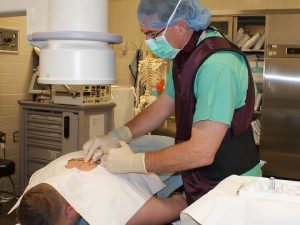
“Chronic Pain Injection” by Army Medicine via Flickr
Personal Injury Protection and the States
Not every state mandates personal injury protection coverage, but in states that do, the minimum coverage is relatively low in comparison to bodily injury and property damage coverage. In contrast, cases where a high PIP coverage might prove helpful or even vital are not difficult to find. In 2018, CDC fact sheet reported that more than 480 people died as a result of car accidents in Oregon state alone, and a CDC report from 2012 found that almost 7,000 people in the United States visited the emergency room on a daily basis with injuries they had suffered in car accidents. From 2012 to 2013, that number amounted to over 2.5 million, with nearly 200,000 hospitalizations.
The CDC also calculated the lifetime medical costs of injuries due to motor vehicle crashes to be up to $18 billion, with another $33 billion lost in lifetime wages due to those injuries. The same report found that each crash-related visit to the emergency room costs, on average, roughly $3,300, with hospital bills stacking up to approximately $57,000 over the course of a single person’s lifetime. However, most calculations for PIP claims are accumulated less than two years after the initial injury.
Findings like these not only reveal the benefits of PIP coverage, but the dire consequences of claim denials.

“Nick @ home” by nicwn via Flickr
Deny, Delay, Defend: How Insurers Have Created An Industry From Elusive Tactics
Some have argued that states like Florida and New York have made it far too easy to take cases such as this to the tort system. Tort claims are the legal system’s way of allowing an injured party to hold another party responsible for damages. This allows even third parties to “bring direct causes of action against insurers” to allege bad faith practices, according to R.J. Lehmann, co-founder of the R Street Institute and contributor to Insurance Journal. But that begs the question: Why are so many class action lawsuits surrounding injuries not covered by auto insurance companies?
For one thing, car accidents can cause injuries ranging from obvious broken bones to soft tissue, which can make some difficult to treat, prove and finally bill through insurance. The Gatti Law Firm reports the most common injuries after a crash involve the spine and head, broken bones, and emotional trauma–all requiring professional care. Gatti warns that while insurance companies claim to be on the side of the customer, some may use deceptive tactics to get out of paying claims to their clients, stating, “When you go through the other person’s insurance, you expect the process to go smoothly. Unfortunately, despite the insurance provider’s duty to care, they often try to turn the tables on you. They’ll claim you were at fault for the accident, your injuries are pre-existing, or their customer’s policy doesn’t cover your losses.”
Cases such as Berg v. Nationwide Mutual Insurance Company, which started with the initial accident in 1996 and ended with the final verdict in 2020, offer reason to pause and reflect on the nature of the insurance industry, whether in regards to personal injury protection or damage and liability coverage. In 1996, the Bergs suffered a severe accident in their Jeep Cherokee. It took eight years for the case to go to trial. In December 2004, the insurance company was found to have violated both the Unfair Insurance Practices and Consumer Protection Law and the Motor Vehicle Physical Damage Appraisal Act for recommending repairs when the vehicle should have been totaled, and sending the Bergs to a shop that performed “improper repairs,” according to James H. Cole, co-chair of the Insurance Services Practice Group.
The Bergs were awarded $295. A decade later, the case resurfaced, and in June of 2014, the trial court favored the Bergs, ordering the insurance company to pay $3 million in attorney’s fees and $18 million in punitive damages. The case was put to rest in 2020, with virtually no changes made to the 2014 decision. This lengthy process was a typical example of the “delay” portion of the “deny, delay, defend” tactic employed by insurance companies.
Although this case pertained more to damages and attorney fees rather than any passenger injury, it is one in a litany of similar lawsuits, as many policyholders noticed similar patterns of bad faith practices.
The List Goes On
In 2018, plaintiff Brett Durant challenged State Farm (see Durant v. State Farm) on their denial of his PIP claim, stating he had already reached “maximum medical improvement” by the time medical follow up bills had been submitted for his physical therapy and cortisone injections. Despite submitting the bills on time, receiving a valid diagnosis every step of the way and having referrals on record for each recommended action, Durant was denied coverage. Top Class Actions reported that State Farm reached an $18.5 million settlement with policyholders due to Durant’s action, as allegations included a denial of coverage to roughly 3,000 other policyholders under the same claim that they had already resolved their injuries.
Geico has also been accused of paying less than their fair share to consumers. In a 2019 class action lawsuit, they were found to have been underpaying PIP benefits. According to Dolman Law Group, the Florida PIP Statute allows for two options: paying 80 percent of the medical expenses deemed reasonable, or the insurance company can pay 80 percent of the allotted amount under Medicare Part B. Class Actions Reporter provided the example of Danielle Russell, who—after being injured in a car accident—was treated by her chiropractor. Despite Russell’s bills coming under the allowed amount for full coverage, the policy’s ambiguous wording allowed GEICO to cover 20 percent less.
In addition, denials and delays may cost more than a dip into their bank account.
In 2004, State Farm refused to pay PIP claims that would have allowed Tara Sadler, a Washington resident and policyholder, to address severe injuries from a car accident. Moreover, SKWC News reported that Sadler’s surgery was continually delayed despite multiple attempts by her physician to alert State Farm of the urgency for surgical intervention. Her conditions then worsened, even to the point of paralysis. When physicians made allowances for the insured’s demand that Sadler be re-evaluated, the evaluation results were met with yet another roadblock, as the only agent appointed to approve coverage was out of office. Karen Koehler, an attorney representing Sadler and her family made her thoughts on the matter clear.
“It is nothing new for insurance companies to unjustly put profits over people by denying PIP claims,” Koehler stated in her interview with SKWC. “But never have I seen this level of callous incompetence. We believe had State Farm done the right thing and stood by its promise to Tara, she would be walking today.”
In fact, the surgery was approved by State Farm 37 days after the emergency recommendation, by which time it was ineffective in preventing Sadler’s paralysis, changing her life drastically.
Denied PIP claims have been a problematic theme for years, as policyholders often grapple with insufficient means to proper legal representation and a lingering fear of retaliation. Only time will tell if these regular occurrences within the tort system change the interactions between insurance companies and the consumer.
